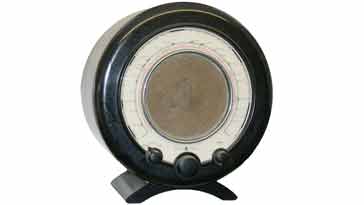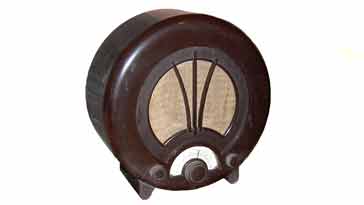EKCO Round Radio Series
The EKCO company produced a large number of radios up until the 1960s, but they were most famous for their vintage round radio with its Bakelite case and unique Art Deco design.
EKCO Radios Includes:
EKCO round radio series
EKCO AD36
EKCO AD65
EKCO A22
EKCO AD75
Iconic radio receivers:
Summary of iconic radio receivers
Radio receiver history
Crystal radio sets
Development of the superhet radio
Radio history / timeline
One of the most iconic or classic vintage broadcast radios must be the round radio series produced by EKCO based in the UK.
These classic antique radios are hugely sought after because of their innovative Bakelite cabinet and the Art Deco design.
Today, the EKCO round radio series including the AD65, which is probably the most well known version today, seem to epitomise the design of the age when broadcast radios were starting to become household items.

What was the EKCO company
The EKCO company as founder as a private company by Eric Kirkham Cole in 1926. Initially the company made battery eliminators because most radios of the time were powered from batteries. The company obtained funding and set up a factory in Leigh-on-Sea in 1927. Later, as the company grew, they moved to a site in Southend-on-Sea.
Later as mains powered radios started to take over from battery powered ones, the business changed to making radios themselves.
The company was very innovative and made a variety of different products including a car radio, although their main line was that of mains powered radios.
EKCO was one of the first companies to use Bakelite for the case of the radios. These provide to be very successful. Initially the cases were made in Germany by AEG, but import duties and the aim to make their own parts meant that they set up their own bakelite manufacturing area adjacent to the Southend-on-Sea factory. During the early 1930s the very large presses needed for Bakelite manufacture were installed at the Southend works and mass production of their own cases began.

Rather than making the sets look like many others, the use of Bakelite meant that they were able to be far more innovative in the design and shape of the radios than many other manufacturers that stayed with wooden cases. To take advantage of this, EKCO employed famous designers including Serge Chermayeff and Wells Coates. As a result the EKCO radios had a far more Art Deco look than anything else on the market at the time.
Bakelite basics
Bakelite was the first form of plastic that was made. It was developed by a Belgian-American chemist named Leo Baekeland in Yonkers, New York, in 1907 - the name Bakelite coming from the inventors name.
It took a couple of years, but Bakelite was patented on 7th December 1909.
Bakelite was a thermosetting phenol formaldehyde resin, which was formed from a condensation reaction of phenol with formaldehyde. It was relatively easy to make and soon found many uses in both domestic and industrial products, including, of course, radios. Its properties of being non-conductive as well as heat resistant made it was useful, but just as a material that could be moulded, but one that could be used in many electrical and electronic products.
EKCO round radio series
There are several different radios that were produced by EKCO within the round radio format. Accordingly there is a selection of different types of these vintage radios available for those wanting to buy. However when they appear in the antique radio markets there is a premium on their price in view of their Art Deco design

The period in which the EKCO round radios were being manufactured saw an explosion in the ownership of radios as the number of broadcast stations started to rise.
Even though broadcast radios represented a large cost for a household, they provided a way in which they could connect with the outside world and be entertained.
As a result a large number of radios were produced by a host of different manufacturers including EKCO. Additionally the radios were regularly updated and designs of both the exterior and interior were changed. As a result there are many different radios that conform to the basic EKCO round radio design.
The first radios with the "round radio" design were introduced in the late 1920s when there were fewer stations around and the need for performance was not as great. Also valves were still quite expensive, although prices were falling. As a result of these and other factors, tuned radio frequency radios were the most widely manufactured format, and the first round radios were of this format.

As the need for better performance arose as more stations came on the air, better selectivity was needed and accordingly the superhet radio became the dominant format for radio designs.
List of EKCO round radio series
There are several models of these antique radios that are available on the market these days. A summary of some of the main types is given in the table below.
| List of EKCO Round Radios |
||
|---|---|---|
| Radio Number | Description | |
| AD36 | This is one of the early round radios and has a tuned radio frequency, TRF format rather than a superhet. It covered the long and medium wave bands and used four valves including the power rectifier. It could be powered by AC or DC. This set was introduced in 1935 as a cheaper alternative to the superhet radios in the range. | Read more |
| AD65 | This is one of the more widely seen EKCO round radios and it was introduced in 1934. It is a superhet covering the long and medium wavebands and the initial versions used four valves. | Read more |
| AD75 | This radio was a broadcast superheterodyne receiver from the EKCO round radio line. It was introduced in January 1940 and covered the long and medium wave bands. It used four valves and had an IF of 480kc/s. | Read more |
| AC76 | This was a five valve superheterodyne radio with an IF of 130 kc/s with very similar looks to the AD75, but for operation only on AC mains power. It had five valves and was introduced in 1935. | |
| A22 | This was the last of the EKCO round radios and introduced in 1945. It was a superhet for the long, medium and short wave bands with an IF of 465kc/s. | Read more |
There were very many different types of radio made by EKCO using Bakelite and with the round styling. They were popular at the time, but like all radios of the time, they were an expensive item, representing considerably more than a week's wages for most workers.
The EKCO round radios have now become an iconic or classic form of vintage radio. Their Art Deco styling has made them very desirable, fitting well into many modern rooms wit their distinctive shape. Some reproduction radios are also available and these may suit some people more than the original items.
More History:
Radio history timeline
History of the radio
Ham radio history
Coherer
Crystal radio
Magnetic detector
Spark transmitter
Morse telegraph
Valve / tube history
PN junction diode invention
Transistor
Integrated circuit
Quartz crystals
Classic radios
Mobile telecoms history
Vintage mobile phones
Return to History menu . . .



